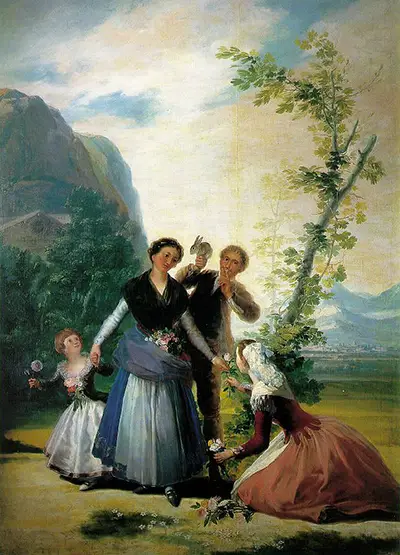In 1786 the fame of Francisco de Goya was at its height. He had already been appointed painter to the Royal Court and was one of Spain's most celebrated portraitists when King Charles III commissioned him to decorate his son's banquetting hall at Prado Palace with tapestries of "gay and pleasant subjects".
As the artist commented in a letter to his friend Martin Zapater, "Just now I am very busy making sketches for a room where the prince eats." Goya was inspired by the use of The Four Seasons as a theme for other Royal Palaces and began immediately to work on four scenes to capture the essence of each season. It was a theme that had already been featured by Jacopo Amigioni in his decor of the Royal box at the Buen Retiro Theatre in Madrid, as well as in the palaces of other Royal families throughout Europe. Goya's interpretation is seen in portfolio of designs supplied for the King's approval: Autumn was "The Grape Harvest", Winter was "The Snowstorm", Summer was "The Threshing Ground", while the fertility, growth and promise of Spring is shown here in "The Flower Girls" (or Las Floreras in its original Spanish).
Each design was first painted in rough form for Royal approval before a finalised draft was completed and sent to the Royal Tapestry Factory of Santa Barbara outside Madrid for the design to be woven into a decorative tapestry to adorn the walls of Prado Palace. In the initial sketch for Las Floreras, Goya showed a smiling mother reaching down to accept a prink rose presented by a kneeling girl by her path while her daughter notices the approach of a man from behind dangling a dead hare from his right hand while a finger of hs left is pressed to his lips to urge nobody to alert the mother to his presence.
Following discusson with the Palace, the final version of the work from which the tapestry was modelled, shows the hare alive and sitting upright in the man's hand. The hare is included as an artistic referece to the fertility of Spring, just as the bunch of flowers in the woman's belt; others in her daughter's hand and another being presented to the mother allude to Spring's promise of growth. Goya adds to the joyful mischievousness of the scene when he paints the man looking directly out of the painting to make eye contact with the viewer as the finger to his lips requests silence for his imminent surprise of the mother.




